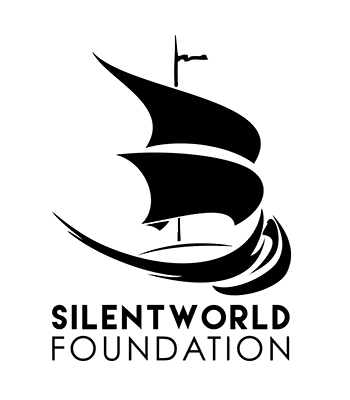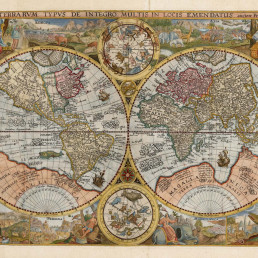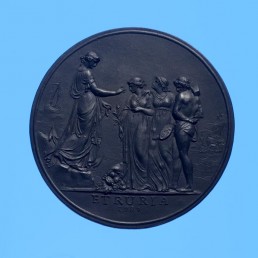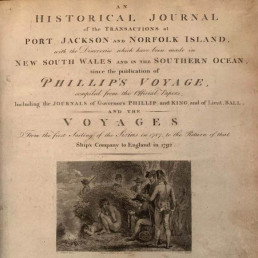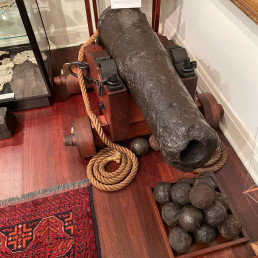
Name/TitleSketch of the town of Perth, Western Australia
About this objectSt George’s Terrace is today the main thoroughfare of Perth. Back in 1832 Charles Wittenoom stood some twenty metrs back from today’s Barrack Street precinct corner as he drew this historically important view of the young township, then known as Swan River Colony. There are other artist renditions of Perth and Fremantle from the 1830s but this particular work is unique with its aspect of St George’s Terrace as it appeared in its earliest form.
To the right is the entrance to what is now Barrack Street, so named for the army barracks which originally stood along the track that continues on the other side of the Terrace. In the foreground, whare a mature Marri tree is depicted leaning over the road, was the residence of the artist’s brother, Reverend John Burdett Wittenoom, who had arrived in Perth in 1830 to take up the position as the colony’s Chaplain, a mere seven months after Lieutenant-Governor, Captain Stirling, had arrived with the first settlers on Parmelia.
Looking east down the Terrace, Wittenoom depicts the principal buildings and native trees and riding towards them in a stylish Stanhope gig is a figure identified by researchers as the Reverend Wittenoom. To the left, the hill gently inclines to the natural ridgeline that Hay Street now follows. The white-washed building shown is the original soldiers’ barracks. In front of this is the Officers’ Barracks and further along, the Military Hospital bounded by Cathedral Avenue with the adjacent gaol at the corner of the Pier Street. Opposite the Officers’ Barracks, visible between the trunk of the Marri tree and the edge of the drawing, is the small cottage which was Captain Stirling’s original home.
MakerCharles Dirck Wittenoom - Artist
Maker RoleArtist
Date Madec1832
Period19th century
Medium and MaterialsPencil, paper, watercolour.
Place MadePerth, Australia
Measurements225mm x 345mm
Object TypeLandscape Paintings
Object numberSF001632
Copyright Licence![]() Attribution - Non-commercial - No Derivatives (cc)
Attribution - Non-commercial - No Derivatives (cc)
Explore by category
Maps and Charts
Date range: 1541-1836
Ship Models
Date range: 1629-1890
Maritime Paintings
Date range: 1793-1849
Manuscripts and Ephemera
Date range: 1768-c1850
Medallions & Convict Tokens
Date range: 1619-1880
Landscapes
Date range: 1768-c1850
Books
Date range: 1694-c1850
Currency and Shares
Date range: 1624-1823
Printed Material
Date range: 1541-1836
Maritime Archaeology
Date range: 1629-1854
Curator's corner
New acquisitions, staff favourites and curios
The mug is decorated with an underglaze and a blue transfer print. On the body, it is titled ‘Emigrants to Australia’. This type of body and glaze was discontinued by 1840. Comparison of the handle shape and the profile of the foot, point to the attribution of manufacture by the Davenport Factory.
Delta was a ship-rigged vessel with two decks and three masts. It was built in Dordrecht, Netherlands in 1839 at the shipyard of Jan Schouten and registered in the same port. Its hull was constructed of oak and sheathed in ‘yellow metal’. Delta was owned by H. van der Sande at the time of its loss and was engaged as a cargo trader.
The Delta carried 29 crew and passengers, while sailing from Melbourne to Batavia in ballast when wrecked at Kenn Reefs on 30 May 1854 whilst under the command of Captain J.G. Kunst. This vessel loss supports the pattern of shipwrecks located on a well-travelled shipping route that was poorly charted until the mid-nineteenth century. The crew of the Delta could see four other shipwrecks at Kenn Reefs at the time of their vessel’s loss.
Important image of a ship associated with Matthew Flinders, that would shortly become one of the most famous early shipwrecks in eastern Australian waters. This is a fine ship’s portrait, by one of the great exponents of the art
